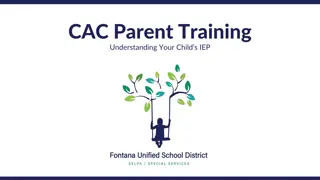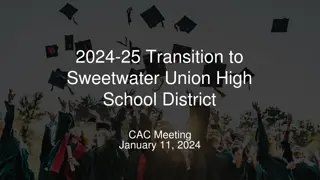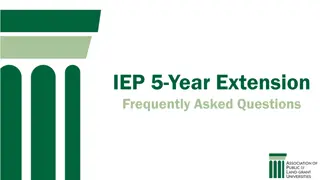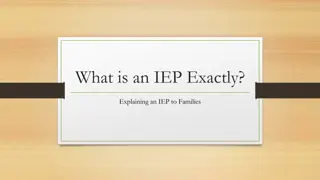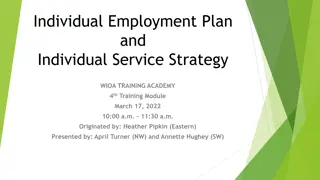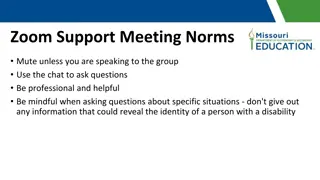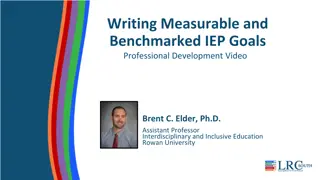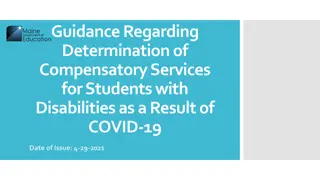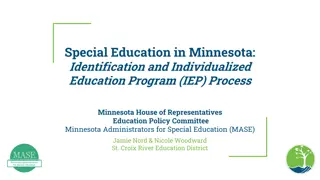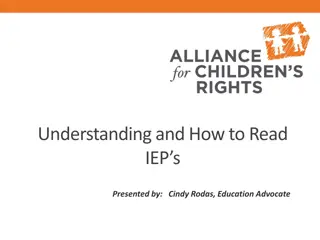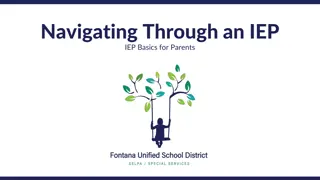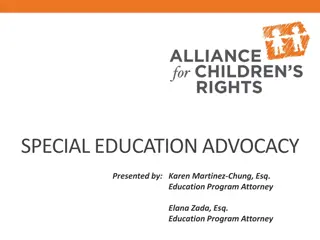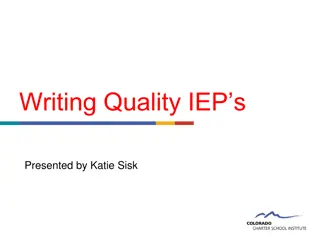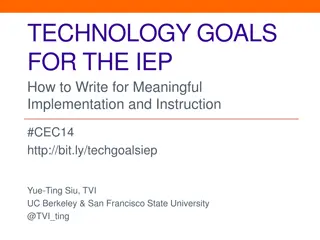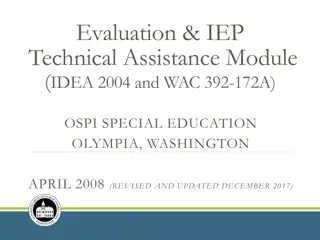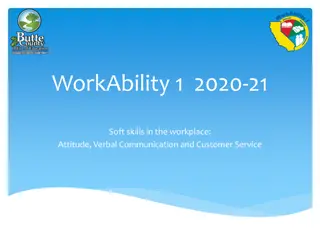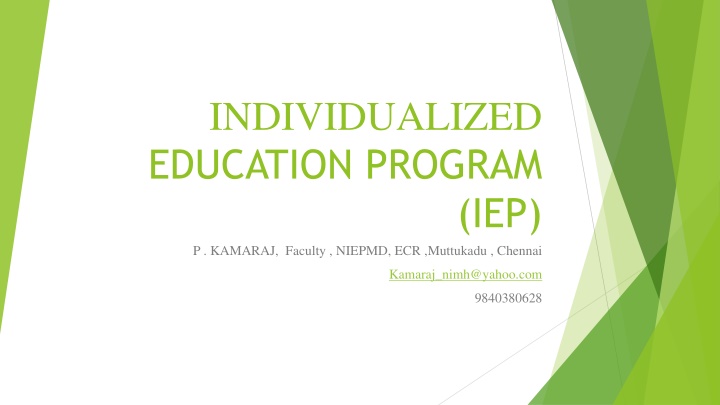
Individualized Education Programs (IEP)
Explore the significance of Individualized Education Programs (IEP) in providing tailored educational services for individuals with disabilities, involving parents and professionals in the process. Learn about the purpose, team dynamics, and driving forces behind creating IEPs, along with the various services and support systems required for effective implementation.
Download Presentation

Please find below an Image/Link to download the presentation.
The content on the website is provided AS IS for your information and personal use only. It may not be sold, licensed, or shared on other websites without obtaining consent from the author. If you encounter any issues during the download, it is possible that the publisher has removed the file from their server.
You are allowed to download the files provided on this website for personal or commercial use, subject to the condition that they are used lawfully. All files are the property of their respective owners.
The content on the website is provided AS IS for your information and personal use only. It may not be sold, licensed, or shared on other websites without obtaining consent from the author.
E N D
Presentation Transcript
INDIVIDUALIZED EDUCATION PROGRAM (IEP) P . KAMARAJ, Faculty , NIEPMD, ECR ,Muttukadu , Chennai Kamaraj_nimh@yahoo.com 9840380628
TNTEU , B.Ed SPECIAL EDUCATION PROGRAM Course 5 : Assessment and Identification of Needs of Persons with Multiple Disabilities Unit III : Multiple Disabilities and other disability conditions Sub Unit 3.4 : Facilitating Teaching Learning , IEP
CONTENTS Concept of IEP Purpose IEP team Process Model case study (hypothetical)
IEP Individualizes Educational Program
DRIVING FORCE TO WRITE IEP PL 94-142 IDEA UNCRPD
INDIVIDUALIZED EDUCATIONAL PROGRAM It is a document written by the professionals with the consultation of parents to provide appropriate service to persons with debilities Document or the record created for the individual with disabilities to provide appropriate service by the professionals. The professionals certainly include the parents in this process
SERVICES MAY BE REQUIRED FOR PERSONS WITH DISABILITIES IN Excluded Education Program, Segregated Education Program , Integrated Education Program or Inclusive Education Program Parent & family training program Parents as co-teacher Related services like Therapeutic , medical and other related services UDL - modification and accommodation Supplementary aids and services including the Assistive Technology Creation of necessary support system Resource room and the necessary resources for learning (accessible library) Support program
PURPOSES OF IEP For decision making to provide the necessary services Placement at the appropriate level To provide follow up services by referring the document To create necessary support for learning To arrange other related services like medical , therapeutic and psychological To integrate and work with other department To communicate the parents To communicate the department To communicate at policy level
PROCESS Screening , Referral Assessment: and reporting the current level of functioning Planning : the annual goals and Short tem objectives instructional methods and strategies , TLM and other supports for teaching , accommodation , program modification and support for school personal Implementation: Creating opportunity for participation in the educational and other related activities , Consideration of LRE , Extended School Year Service Evaluation: Monitoring the progress of ongoing program Review / feed back ,considerations of feed back and continue the process
PROFESSIONALS INVOLVED IN DEVELOPING IEP Specialised Medical Service Professionals like Developmental paediatrics , Psychiatrist , Physiatrist , Ophthalmologist , ENT , Orthopaedics . Special Educators Psychologist Therapists (PT ,OT ,Speech & Audio , POE and other therapists) Allied Health care professionals like Nurse , dentist , Dietician
TEAM MEMBERS Parents Special Educators and the General Education Teachers Therapists Psychologist Medical Service Professionals and allied health service professionals
A HYPOTHETICAL DOCUMENT OF A CASE STUDY TO DEVELOP , IMPLEMENT AND EVALUATE IEP Introduction and Complaints: Master Kannan 7 year old boy was brought by his parents with the complaints that the boy doesn't sit at one place in the classroom. He is not playing cooperatively with other children in the class room. The parent are living in urban place with middle socio economic status. Referral: The teacher suggested the parents to consult a doctor or take him to any organisation to provide some service for him as he is not benefitting in the classroom.
HISTORY OF THE CHILD Past history : The history reveals that the child was born on Prematurity Absence of birth cry Low birth weight No other significant information were reported by the parents during prenatal , natal and post-natal periods.
HISTORY OF THE CHILD The immunizations were given as per the schedules. The developmental history reveals that the child shows delay in achieving the language , cognitive and social milestones. He was able to achieve the motor milestones on time. He was born on non consanguineous marriage living in a nuclear family. The family consisting of parents and one brother. His brother is elder and studying 4ndgrade. There is no history of family members affected with any disabilities or health conditions.
HISTORY OF THE CHILD He is admitted in a primary school. The teacher reports that he is not sitting at one place. He is not able to tell the words clearly and he doesn t play with other children. Reportedly his performance are poor in school activities
MULTIDISCIPLINARY TEAM ASSESSMENT AND EVALAUTION FOR ELIGIBILITY TO RECEIVE SPECIAL EDUCATION PROGRAM The assessment conducted by the medical professional reveals that the boy had average build , active and was born on non -consanguineous marriage. He was born with pre maturity , absence of birth cry and low birth weight. No other medical complications were elicited and no medications are suggested at present. However the influence of perinatal factors may lead the child to become restlessness , inattentiveness and other problem behaviours that makes an adverse effect on learning
MULTIDISCIPLINARY TEAM ASSESSMENT AND EVALAUTION FOR ELIGIBILITY TO RECEIVE SPECIAL EDUCATION PROGRAM The assessment conducted by psychologist reveals that he shows mild impairment in performing the developmental activities for his age. He was not sitting at one place to complete the given task He shows some of the features of autism but on assessment he is not found to be autistic. Mild developmental delay with behaviour problem
MULTIDISCIPLINARY TEAM ASSESSMENT AND EVALAUTION FOR ELIGIBILITY TO RECEIVE SPECIAL EDUCATION PROGRAM The initial assessment conducted by the special educator reveals that He is able to perform the gross and fine motor activities as per his age. He shows poor tripod grip. He does not touches the sticky food items/ He eats dry food . Mother feeds him as he takes long time to eat. He uses spoon for eating and spills the food His mother brushes his teeth as he chew the brush and take long -time to complete the task. He takes his mothers help for bathing , He shows irregular bowel movements and mother helps him for his toilet needs. He understands simple commands and speaks words which is in close contact with his daily experiences. He does not effectively uses his body parts for communication. He is cordial with all the family members , visits his neighbour houses and get simple work assign to him. He often lost his way while taken to a new places
MULTIDISCIPLINARY TEAM ASSESSMENT AND EVALAUTION FOR ELIGIBILITY TO RECEIVE SPECIAL EDUCATION PROGRAM He is attending primary school program. He could match the primary colours such as red , blue and yellow , Identifies the shapes, sizes , day and night , coins up to 5 rupees. He was not able to tell the names of colours sizes ,shapes consistently He turns the pages in the picture books and identifies the pictures of animals , vehicles , vegetable and fruits. He was unable to tell the names of animals , vehicles vegetables and fruits. He scribbles on the paper but shows poor pencil grip while scribbling. Tells the numbers orally up to 5 He plays alone , likes be with his mother . He likes to have chips and he does not like to have bananas. He does not sit at one place and often move from one place to another place. His functional level is Primary education with frustration. He needs high support to learn the cognitive , communication and social skills and he needs intermittent support on other developmental areas which prepares him to accommodate and benefit in the mainstream school.
DIAGNOSIS, ELIGIBILITY AND DECISION TO DEVELOP IEP Based on the assessment made by the experts it is reported that he shows mild intellectual impairment and problem behaviours with the functional level of Primary education program with frustration. The condition may be due to the influence of prenatal episodes. Further he needs the following services to include in the school and other program Special Education Communication program Positive Behavioural Intervention Sensory Integration Program
DETAIL ASSESSMENT , PROGRAM PLANNING AND EVALUATION (FEEDBACK) TO REVIEW THE PLAN The detail assessment is conducted by The Medical Personal Special Educators Psychologist Communication Therapist Occupational Therapist To make a constructive plan for total development of the child
DETAIL ASSESSMENT , PROGRAM PLANNING AND EVALUATION (FEEDBACK) TO REVIEW THE PLAN The professional make their own assessment using the tool relevant to the problem or condition The professionals identify the needs of children to provide the intervention on the basis of priority and develop the goals and objectives to work on and achieve he targets. The feed back is received periodically to make necessary changes in the program.
SPECIAL EDUCATION ASSESSMENT , PROGRAM PLANNING AND EVALUATION Comprehensive Special Educational Assessment Report Date: 06.06.2020 Name of the child :21312 Fathers/Guardian s Name: 3221138 Date of Birth/Age : 02.06.2013/ 7 Years Sex: Male Registration Number : 235/ 20 Diagnosis: Mild ID with ASD features and ADD Parent brought the boy for assessment and further rehabilitation program on 13.06.2020
ASSESSMENT TOOL: FUNCTIONAL ASSESSMENT Dominos PERSONAL SKILLS Current Level of Functioning on the Activities He is able to walk , run and climb the stairs He is able to hold the objects using both the hands and manipulate it. He shows poor tripod grip He does not touches the sticky food items He eats dry food . Mother feeds him as he takes long time to eat. He uses spoon for eating and spills the food while eating He cooperates for brushing mother brushes his teeth as he chew the brush and take long -time to complete the task. He takes his mothers help for bathing. He shows irregular bowel movements and runs to the toilet without telling any one . Mother helps him for his toilet needs. He reciprocates in anticipation of others. He plays with other children under supervision Visits his neighbour houses and get simple work assign to him. He often lost his way while taken to a new places. He communicates using simple words one word. He shows poor SOCIAL SKILLS
ASSESSMENT TOOL: FUNCTIONAL ASSESSMENT ACADEMIC SKILLS He understands simple commands He tells the name of the objects , persons and places which is in close contact with his daily experiences. He does not effectively uses his body parts for communication. He turns the pages and looks at the pictures of animals , vehicles ,fruits and vegetables. He matches the animals , vegetables and fruits. OCCUPATIONAL SKILLS Helps mother in doing simple house hold works Serves water to others on request RECREATIONAL SKILLS Watches TV for 5 minutes. Likes to go for outing Plays swings at home and at park
SELECTION OF ANNUAL GOALS The annual goal or the year plan is made based on his current level of performance , the strength and weaknesses shown in the functional assessment. Following are the annual goals selected for the child to learn To enhance his toilet skills To enhance his dressing skill To enhance his brushing skills To enhance his functional academic skills To enhance his communication skills To enhance age appropriate occupational skills.
SELECTION OF OBJECTIVES FOR THE CHILD TO LEARN IN THE FIRST QUARTER The objectives are framed from the annual goal for the child to learn for a period of 3 months. Given below some of the Objectives are selected for he child to learn during this quarter To indicate his toilet needs. To identify 5 vegetables in the functional usage To play cooperatively with two or more children These objectives are needs to be stated very specifically for the child to perform Justification also needs to be given upon selecting the goal
STATEMENT AND NATURE OF OBJECTIVES The objective needs to be stated very specifically with the components of the Content , Condition , Criteria and Duration It also follow the guidelines of SMART : Specific , Measurable , Achievable , Realistic with in the Time limit Example Objective: To identify the 3 vegetables in the functional situation ( Potato , tomato and ladies finger) Statement: When Kavi is taken to the vegetable shop (Condition) , he has to identify 3 vegetables such as potato , tomato and ladies finger (Content) with 80% accuracy (Criteria) over a period of 3 month (Duration) of training The teaching procedure needs to be clearly written with , teaching methods , teaching strategies , techniques and the materials , environment in which the activities are to be conducted.
TEACHING PROCEDURE INCLUDES The methods and approaches of teaching (chid centres/ activities / holistic) The teaching strategies and techniques ( Task Analysis , Reinforcement , modelling , shaping , chaining , prompting & fading ) The materials ( Concrete materials , semi concrete martials , abstract materials like , use of assistive devices , ICT and assistive technologies ) The environment (Class room , home , play area & community) The best practices used for the child to learn the objectives
EVALUATION Monitoring the program at regular interval or periodically through Formative and summative evaluation To get the feed back of the performance on set criterial for the individual To decide upon the progress whether to continue or modify or to select next higher level of objective for the child to learn. The evaluation may be reported either quantitatively and or qualitatively
IEP RELATED OTHR SERVICES Occupational Therapy Physio therapy Speech , Language and Commination therapy Prosthetic and Orthotic services Psychologist Use of Technology Transport and other services
REFERENCES Federal Act PL 94-142 .Education For All (1995) . United States. Individuals with Disability Education Act (2004) United States. Office of Special Education Program (2019). United States.

